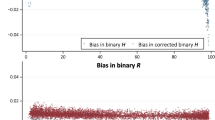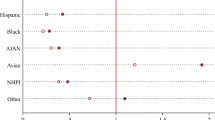Abstract
Reports of rising income segregation in the United States have been brought into question by the observation that post-2000 estimates are upwardly biased because of a reduction in the sample sizes on which they are based. Recent studies have offered estimates of this sample-count bias using public data. We show here that there are two substantial sources of systematic bias in estimating segregation levels: bias associated with sample size and bias associated with using weighted sample data. We rely on new correction methods using the original census sample data for individual households to provide more accurate estimates. Family income segregation rose markedly in the 1980s but only selectively after 1990. For some categories of families, segregation declined after 1990. There has been an upward trend for families with children but not specifically for families with children in the upper or lower 10% of the income distribution. Separate analyses by race/ethnicity show that income segregation was not generally higher among Blacks and Hispanics than among White families, and evidence of income segregation trends for these separate groups is mixed. Income segregation increased for all three racial groups for families with children, particularly for Hispanics (but not Whites or Blacks) in the upper 10% of the income distribution. Trends vary for specific combinations of race/ethnicity, presence of children, and location in the income distribution, offering new challenges for understanding the underlying processes of change.


Similar content being viewed by others
Data Availability
All data sets used are held within the FSRDC under strict confidentiality rules. Segregation indices have been approved for disclosure by the U.S. Census Bureau and are posted on the Brown University website of the Initiative on Spatial Structures in the Social Sciences developed by John Logan: https://s4.ad.brown.edu/projects/diversity/Data/data.htm.
Notes
By taking a second-order expansion of the entropy function around the fraction pj of households in tract j with income below some given level and taking expectations, Logan et al. (2018) showed that the expected bias in any given tract j is \( \frac{E{\left({\hat{p}}_j-{p}_j\right)}^2}{p_j\left(1-{p}_j\right)}=\frac{p_j\left(1-{p}_j\right)/{N}_j}{p_j\left(1-{p}_j\right)}=\frac{1}{N_j} \), where \( {\hat{p}}_j \) is the corresponding fraction in the sample. This expression assumes the sample is done with replacement. Logan et al. also derived expressions for the case without replacement, which corresponds to the ACS procedure. This latter approach, however, complicates the resulting mathematical expressions and does not lead to a measurable improvement in performance in our simulated data.
Reardon et al. (2018) subsequently advanced a somewhat similar correction that applied to H and R but not NSI. It has two other limitations. First, the derivation of their correction depends on the assumption that no systematic bias is introduced by grouped data. We show in the online appendix that there may in fact be distortions due to inability to model the upper and lower tails of the income distribution. Second, in grouped data, the sample weights have been applied, but they are invisible to the researcher. Therefore, it is not possible to correct for weighting, which we discuss later. A more useful tack is to turn to unit-level household data in the RDC, as we do here.
We use the fact that if yi is income and wi is the weight normalized such that ∑wi = 1, then \( Var\left(\sum {w}_i{y}_i\right)=\sum {w}_i^2 Var\left({y}_i\right) \).
Reassuringly, this expression reduces to \( \frac{1}{N_j} \) in the case that all sampled families have equal weight, which would be the case with unweighted data, so that \( {w}_{ij}=\frac{1}{N_j} \). Note that we are in effect disregarding differences in weights across tracts. This is reasonable because the published census data in 2000 provide the true tract sizes and total population (not their sample analogs), and the ACS data include adjustments based on census 2010 full counts.
A fully corrected estimate of RR could be constructed by weight-correcting Rp for every value of p and then computing the p(1 – p) weighted average of the weight-corrected values.
We also calculated changes in the unweighted averages, yielding very similar patterns. We prefer to weight by the number of families so that the statistic reflects the experience of the average family, the average family with children, or the average White, Black, or Hispanic family with or without children, in large metropolitan regions.
References
Bischoff, K., & Reardon, S. F. (2014). Residential segregation by income, 1970–2009. In J. R. Logan (Ed.), Diversity and disparities: America enters a new century (pp. 208–233). New York, NY: Russell Sage Foundation.
Florida, R., & Mellander, C. (2015). Segregated city: The geography of economic segregation in America’s metros (Report by the Martin Prosperity Institute). Toronto, Ontario, Canada: University of Toronto. Retrieved from http://martinprosperity.org/media/Segregated%20City.pdf
Fry, R., & Taylor, P. (2012). The rise of residential segregation by income (Social & Demographic Trends Report). Washington, DC: Pew Research Center. Retrieved from https://www.pewresearch.org/wp-content/uploads/sites/3/2012/08/Rise-of-Residential-Income-Segregation-2012.2.pdf
Jargowsky, P. A. (1996). Take the money and run: Economic segregation in U.S. metropolitan areas. American Sociological Review, 61, 984–998.
Logan, J. R., Foster, A., Ke, J., & Li, F. (2018). The uptick in income segregation: Real trend or random sampling variation? American Journal of Sociology, 124, 185–222.
Logan, J. R., Zhang, W., & Chunyu, M. (2015). Emergent ghettos: Black neighborhoods in New York and Chicago, 1880–1940. American Journal of Sociology, 120, 1055–1094.
Massey, D. S., & Eggers, M. L. (1993). The spatial concentration of affluence and poverty during the 1970s. Urban Affairs Quarterly, 29, 299–315.
Massey, D. S., & Fischer, M. J. (2003). The geography of inequality in the United States, 1950–2000 (Brookings-Wharton Papers on Urban Affairs). Washington, DC: Brookings Institution Press.
Mayer, S. E. (2001). How the growth in income inequality increased economic segregation (Working paper). New York, NY: Russell Sage Foundation. https://www.russellsage.org/sites/all/files/u4/Mayer_How%20the%20Growth.pdf
Owens, A. (2016). Inequality in children’s contexts: Income segregation of households with and without children. American Sociological Review, 81, 549–574.
Reardon, S. F., & Bischoff, K. (2011). Income inequality and income segregation source. American Journal of Sociology, 116, 1092–1153.
Reardon, S. F., Bischoff, K., Owens, A., & Townsend, J. B. (2018). Has income segregation really increased? Bias and bias correction in sample-based segregation estimates. Demography, 55, 2129–2160.
Reardon, S. F., Fox, L., & Townsend, J. (2015). Neighborhood income composition by household race and income, 1990–2009. Annals of the American Academy of Political and Social Science, 660, 78–97.
Watson, T. (2009). Inequality and the measurement of residential segregation by income. Review of Income and Wealth, 55, 820–844.
Wilson, W. J. (1987). The truly disadvantaged: The inner city, the underclass, and public policy. Chicago, IL: University of Chicago Press.
Yang, R., & Jargowsky, P. A. (2006). Suburban development and economic segregation in the 1990s. Journal of Urban Affairs, 28, 253–273.
Acknowledgments
This research was supported by the Sociology Program of the National Science Foundation (grant 1756567) and National Institutes of Health (1R21HD078762-01A1). The Population Studies and Training Center at Brown University (P2CHD041020) provided general support. We thank Todd Gardner of the U.S. Census Bureau for his assistance in working with census data through the FSRDC network. Any opinions and conclusions expressed herein are those of the author(s) and do not necessarily represent the views of the U.S. Census Bureau. All results have been reviewed to ensure that no confidential information is disclosed.
Author information
Authors and Affiliations
Contributions
All authors contributed to the study concept and design. Data preparation in the FSRDC was performed by Todd Gardner, Charles Zhang, and Hongwei Xu. Methodological innovations and programming were developed primarily by Andrew Foster. Analysis of income segregation patterns was carried out primarily by John Logan. The first draft of the manuscript was written by John Logan, and all authors commented on subsequent versions of the manuscript. All authors read and approved the final manuscript.
Corresponding author
Ethics declarations
Ethics and Consent
The authors report no ethical issues.
Conflict of Interest
The authors declare no conflicts of interest.
Additional information
Publisher’s Note
Springer Nature remains neutral with regard to jurisdictional claims in published maps and institutional affiliations.
Electronic supplementary material
ESM 1
(PDF 417 kb)
Rights and permissions
About this article
Cite this article
Logan, J.R., Foster, A., Xu, H. et al. Income Segregation: Up or Down, and for Whom?. Demography 57, 1951–1974 (2020). https://doi.org/10.1007/s13524-020-00917-0
Published:
Issue Date:
DOI: https://doi.org/10.1007/s13524-020-00917-0




